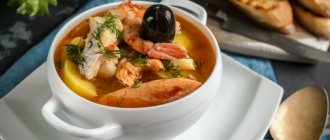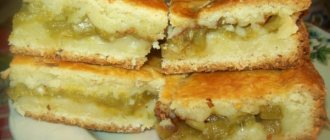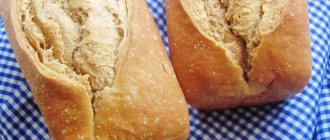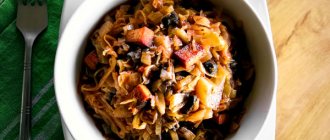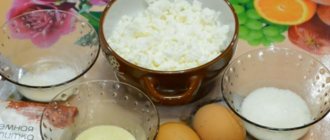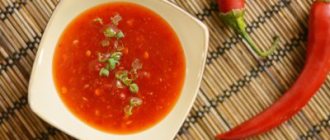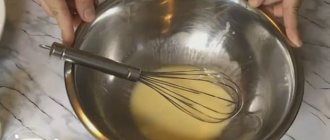Yorkshire pudding is an iconic English pastry, a special chapter of world cuisine, the recipes of which have been familiar to more than one generation of residents of the country. Essentially, these are buns made from thin batter poured into greased molds. For the British, this is the main part of Sunday lunch, sometimes eaten before the main meat course. But basically, pudding is used to catch meat juices or fat from baked meat with a piece of bun.
The history of the creation of “dripping” pudding is interesting. In the old days, Yorkshire cooks came up with an ingenious way to use the fat that dripped down while cooking meat. They set up the trays and then poured the dough into it.
The modern recipe differs in cooking technology, but remains invariably popular. Crispy on the outside and soft on the inside, puddings come with a variety of fillings. I'll introduce you to a couple of them.
- 1 Yorkshire pudding - classic step-by-step recipe
- 2 Filling for Yorkshire pudding
- 3 Video recipe for Yorkshire pudding from Jamie Oliver
Yorkshire pudding - classic step-by-step recipe
Take:
- Flour – 1.5 cups.
- Eggs – 4 pcs.
- Milk – 1.5 cups.
- Sunflower oil - a couple of spoons.
- Salt – a pinch.
Step by step recipe
Beat the eggs into a bowl, use the mixer to beat until foamy.
Pour in the milk. Continue whisking the contents.
It is advisable to sift the flour, enriching it with oxygen. I advise you to add it without stopping the mixer, so the lumps will break up faster. Don't forget to salt the dough during the process.
Many chefs advise putting the finished dough in the refrigerator for half an hour, but you can skip this manipulation.
For baking we will need a metal mold for small muffins. Pour sunflower oil into each compartment. Place in the oven for 15 minutes so that the oil and pan warm up thoroughly. The oven temperature is approximately 190 o C.
Fill the heated pan with dough. It is very important here not to touch the edges of the compartments, otherwise the dough will “grind” and prevent the sides of the pudding from rising. For convenience, I pour the dough into a plastic bottle, and then quickly and carefully pour it. Fill approximately ¾ of the recess volume.
Place the pieces for 20-25 minutes, waiting for them to rise and nicely brown.
This will happen soon after the start of cooking, they will begin to grow literally before our eyes.
Depending on the features of your oven, the temperature inside can be increased to 200 o C, and even more.
Video recipe for making Yorkshire pudding
Make Yorkshire pudding at home with this great video and expert cooking tips.
English cuisine is famous for its various puddings.
. We can say that the residents and culinary specialists of this country are obsessed, in the good sense of the word, with the recipes for this interesting dish. Now you can count several hundred such recipes. Puddings can be sweet, salty, snack, with fish, meat, and even dedicated to some holiday. Thus, for example, not a single Christmas table in a traditional English family is complete without Christmas pudding.
Here are a few more options for preparing the most famous dish of English cuisine.
- Try your culinary skills and cook an interesting one. This dish is distinguished not only by its taste, but also by its benefits.
- And if you have semolina at home and you don’t know where to use it, other than in preparing banal semolina porridge, then try making an unusual one. I am sure that all members of your family will be surprised by this dish.
- And be sure to try the recipe in action.
Dear housewives, often a dish with a loud and complex name does not mean anything complicated and impossible. Don't be intimidated just because the dish is called Yorkshire pudding. As practice and this recipe have shown, there is nothing complicated or expensive in preparing this dish. Therefore, cook for your health, take risks, experiment and delight your loved ones with your culinary achievements. Write your recipe options in the comments, leave reviews and be happy. Bon appetit!
Yorkshire pudding is an iconic English pastry that comes from the culinary traditions of Yorkshire. Real Yorkshire pudding is not like what we understand as traditional English puddings, it is prepared (baked) from batter (batter). A proper Yorkshire pudding should be light, airy, tender on the inside and crispy on the outside. In addition, according to the British Royal Society of Chemistry in 2008, this dish cannot be less than 4 cm in height. The pudding batter is made from eggs, wheat flour and milk, possibly with the addition of spices and dried herbs. Small Yorkshire puddings are usually baked and are traditionally served hot as part of a Sunday lunch with roast beef and gravy, steamed vegetables, and sometimes fish.
Origins of the recipe
Historically, Yorkshire pudding was invented as a convenient and economical way to bake puddings at the same time as roasting meats. The fat from the frying meat dripped onto the tray with puddings - thus, everything cooked faster. The recipe for the so-called dripping pudding was first published in 1737. In 1747, Hannah Glace's book The Art of Cookery Explained was published, in which this famous woman cook published her variations on the method of preparing a dish called Yorkshire pudding.
English Sunday lunch
Yorkshire pudding forms a major part of the traditional definition of an "English dinner" and is in some cases served before the main meat course. After eating the puddings, the main meat dish is served (often with béchamel sauce) with vegetables and herbs. However, this is a Sunday or holiday option. In the family version, puddings are served immediately with the first or second courses after appetizers, simply instead of bread. By the way, although sweet puddings are not a tradition, today a sweet version is also often prepared for the children's table.
How to make Yorkshire pudding?
Ingredients:
- 0.3 cups of milk;
- 0.3 cups of wheat flour per chicken egg (a cup is a standard volume measure corresponding to 250 g).
Preparation
The batter recipe is extremely simple, even novice cooks can do it. Currently, Yorkshire puddings are baked as follows: pour a medium-thick batter of flour, milk and eggs into refractory molds in which butter is boiled (usually muffin and cupcake molds are used).
Preparing the pudding dough
In fact, it's quite easy to make authentic Yorkshire pudding even in a regular kitchen. The recipe is very simple.
Ingredients
- 2 chicken eggs;
- 300 ml milk;
- 1 teaspoon of vegetable oil for each 100 ml mold;
- a glass of flour;
- a pinch of salt;
- a little ground black pepper (to taste).
Preparation:
Sift the flour into a bowl (required), add salt, a little pepper and mix thoroughly. Make a hole in the center of the mound of flour. Beat eggs and milk. Carefully pour the milk-egg mixture into the flour. Beat the batter well until smooth (you can use a mixer). Cover the container with the dough and put it in the refrigerator (but not in the freezer) for an hour. Baking pudding correctly
Preheat the oven to medium-high temperature (approximately 220ºC). We use silicone molds for muffins: place the molds on a tray, pour a little oil into each cavity of the mold and place in the oven for 10 minutes so that the oil heats up well, almost boiling. Carefully, without sudden movements or distortions, remove the tray from the oven chamber and fill the molds with batter using a ladle or jug. Carefully return the tray to the oven and bake for 20-30 minutes until a beautiful golden brown crust forms. Don't be discouraged if the puddings don't turn out too smooth - this is normal. Serve immediately - Yorkshire puddings are eaten hot, although they are also quite suitable for eating when slightly cooled.
Yorkshire pudding is a small miracle, there’s no other way to describe it. Imagine my surprise when the ordinary dough turned out to be fluffy and ruddy donuts with emptiness inside.
These puddings are perfect for breakfast; you just need to make the dough the night before and put it in the refrigerator.
Yorkshire pudding is prepared in both small and large forms. So far I’ve tried to do it only in portions, it’s more convenient for us. Puddings have a neutral taste, somewhat similar to pancakes, and can be eaten with various additives. We like it with melted cheese and curd mass.
It is best to prepare the dough the night before or be sure to let it sit for at least three hours. It is more convenient to make the dough in a blender, add all the ingredients and beat thoroughly.
If you don't have a blender, knead the dough by hand so that there are no lumps.
In the morning, stir the dough. Grease the molds generously with melted butter (this is mandatory). Fill the molds 2/3 full.
Place in a preheated oven (temperature 230 degrees). Bake for 20 minutes, do not open the door (this is important). After time has passed, do not open the oven immediately, take out the pudding after a few minutes.
A Yorkshire pudding isn't a Yorkshire pudding unless it has 4 inches. This is exactly what the proverb says in England, whose cuisine is simply replete with recipes for all kinds of puddings. Moreover, these are not only sweet, dessert dishes, but also snack options - such as, for example, the famous Yorkshire pudding. We’ll prepare it today, and in no time!
Probably, many chefs and simply food lovers know about this dish. In fact, this rather intriguing name hides just simple baking based on pancake dough. Yes, yes, Yorkshire pudding is an unleavened dough made from milk, eggs and wheat flour in the form of a liquid batter, which is baked in portions at high temperature. As a result, the batter inflates very strongly and under the ruddy crispy crust a delicate dough and an impressive cavity are formed.
Most often, Yorkshire pudding is served warm (that is, immediately after cooking) as an accompaniment to baked meat (roast beef) with gravy. Since these pancake buns are hollow inside, they are sometimes filled with various salads, mousses and snack spreads.
What does Yorkshire pudding look like and what does it taste like? Let's say, for profiteroles, only softer. They also have a slight eggy smell, which is not at all surprising and quite predictable. In general, everyone’s attitude towards them is different: some people love Yorkshire pudding, others don’t care, and some absolutely don’t like it. But to find out your attitude towards these pancake buns, you need to cook them at least once, right?
Yorkshire pudding filling
You can fill the pudding in different ways. Sweet filling is better for children. I made it from feta cheese with garlic, dill and basil.
Take the ingredients by eye. Chop the seasoning sprigs, crush the garlic and mix with soft cheese. You can use cottage cheese instead.
All that remains is to break the pudding, spread it with the delicious filling and start testing.
Filling No. 2.
Mash a hard-boiled egg, add to soft processed cheese, crush a clove of garlic and mix with mayonnaise.
Filling No. 3.
Grate the hard cheese, add finely chopped ham, a spoonful of canned corn and mayonnaise.
In addition to the listed products, you can add mushrooms, liver pate, butter, or any salad with mayonnaise to the pudding filling. Sweet fillings often include jam or finely chopped fruit.
Pudding filling
Now we’ll tell you how to prepare the filling for this pudding, following Oliver’s advice. Strain the juice of one whole lemon into sour cream or natural yogurt, passed through a sieve. Please note that no bones should be included in the mixture.
Wash a bunch of dill (you can take it in a very small size), dry it and chop it as finely as possible. Add sour cream and lemon juice. After stirring with a whisk, grate the horseradish root on top.
If necessary, you can add a little salt to the resulting sauce and add the spices you like best. Ground black pepper will do. But this is not at all necessary.
Cut the salmon into small portions.
Story
Small Yorkshire puddings served as part of a Sunday lunch
When wheat flour began to be used in making pies and puddings, cooks in Northern England came up with a way of using the fat that dripped onto the pan to cook the puddings while the meat was roasting. In 1737, the recipe for A Dripping Pudding was published in The Whole Duty of a Woman:[1]
| Prepare a good batter, as for pancakes; place (the batter) in a hot pan over the fire, greased with fat, so that it is slightly browned on the bottom, and then place the pan under the piece of mutton so that the hot fat drips onto the pudding. The pan needs to be shaken frequently from time to time to ensure the pudding is light and tasty. When the lamb is ready, you can take out the pudding; turn it out onto a platter and serve hot. Original text (English) Make a good batter as for pancakes; put in a hot toss-pan over the fire with a bit of butter to fry the bottom a little then put the pan and butter under a shoulder of mutton, instead of a dripping pan, keeping frequently shaking it by the handle and it will be light and savory, and fit to take up when your mutton is enough; then turn it in a dish and serve it hot. |
Similar recipes were published in 1747 in Hannah Glace's book, The Art of Cookery Explained, under the title Yorkshire Pudding. Hannah Glace adapted and renamed the original recipe, which was previously called "Dripping Pudding" and had been baked in England for centuries, although these puddings were flatter than today's puddings.[2]
In 2008, the Royal Society of Chemistry ruled that:
| A Yorkshire pudding is not a Yorkshire pudding if it is under four inches.[3] Original text (English) A Yorkshire pudding isn't a Yorkshire pudding if it is less than four inches tall. |
Yorkshire pudding is a staple of British Sunday lunch, and in some cases is eaten before the main meat course. This was the traditional way of eating pudding and is still common in parts of Yorkshire. Since the rich gravy from roasted meats has already been used at the first meal, the main meat course and vegetables are often served with parsley or béchamel sauce.
It is often argued that the main point of this dish is its cheapness - Yorkshire pudding is much cheaper than other lunch items - and therefore fewer of the more expensive items are used, since the pudding is traditionally served first.[4]
Yorkshire pudding recipe. Calorie, chemical composition and nutritional value.
Nutritional value and chemical composition of Yorkshire pudding.
The table shows the nutritional content (calories, proteins, fats, carbohydrates, vitamins and minerals) per 100 grams of edible portion.
| Nutrient | Quantity | Norm** | % of the norm in 100 g | % of the norm in 100 kcal | 100% normal |
| Calorie content | 225.8 kcal | 1684 kcal | 13.4% | 5.9% | 746 g |
| Squirrels | 10.5 g | 76 g | 13.8% | 6.1% | 724 g |
| Fats | 7 g | 56 g | 12.5% | 5.5% | 800 g |
| Carbohydrates | 30 g | 219 g | 13.7% | 6.1% | 730 g |
| Organic acids | 0.1 g | ~ | |||
| Alimentary fiber | 1.3 g | 20 g | 6.5% | 2.9% | 1538 g |
| Water | 49.6 g | 2273 g | 2.2% | 1% | 4583 g |
| Ash | 2.044 g | ~ | |||
| Vitamins | |||||
| Vitamin A, RE | 97.9 mcg | 900 mcg | 10.9% | 4.8% | 919 g |
| Retinol | 0.093 mg | ~ | |||
| beta carotene | 0.026 mg | 5 mg | 0.5% | 0.2% | 19231 g |
| Vitamin B1, thiamine | 0.098 mg | 1.5 mg | 6.5% | 2.9% | 1531 g |
| Vitamin B2, riboflavin | 0.265 mg | 1.8 mg | 14.7% | 6.5% | 679 g |
| Vitamin B4, choline | 126.75 mg | 500 mg | 25.4% | 11.2% | 394 g |
| Vitamin B5, pantothenic | 0.866 mg | 5 mg | 17.3% | 7.7% | 577 g |
| Vitamin B6, pyridoxine | 0.155 mg | 2 mg | 7.8% | 3.5% | 1290 g |
| Vitamin B9, folates | 17.123 mcg | 400 mcg | 4.3% | 1.9% | 2336 g |
| Vitamin B12, cobalamin | 0.489 mcg | 3 mcg | 16.3% | 7.2% | 613 g |
| Vitamin C, ascorbic acid | 0.5 mg | 90 mg | 0.6% | 0.3% | 18000 g |
| Vitamin D, calciferol | 0.793 mcg | 10 mcg | 7.9% | 3.5% | 1261 g |
| Vitamin E, alpha tocopherol, TE | 1.327 mg | 15 mg | 8.8% | 3.9% | 1130 g |
| Vitamin H, biotin | 10.323 mcg | 50 mcg | 20.6% | 9.1% | 484 g |
| Vitamin K, phylloquinone | 0.4 mcg | 120 mcg | 0.3% | 0.1% | 30000 g |
| Vitamin RR, NE | 2.9386 mg | 20 mg | 14.7% | 6.5% | 681 g |
| Niacin | 0.566 mg | ~ | |||
| Macronutrients | |||||
| Potassium, K | 196.67 mg | 2500 mg | 7.9% | 3.5% | 1271 g |
| Calcium, Ca | 112.79 mg | 1000 mg | 11.3% | 5% | 887 g |
| Silicon, Si | 1.6 mg | 30 mg | 5.3% | 2.3% | 1875 |
| Magnesium, Mg | 20.22 mg | 400 mg | 5.1% | 2.3% | 1978 |
| Sodium, Na | 469.65 mg | 1300 mg | 36.1% | 16% | 277 g |
| Sera, S | 113.63 mg | 1000 mg | 11.4% | 5% | 880 g |
| Phosphorus, Ph | 163.4 mg | 800 mg | 20.4% | 9% | 490 g |
| Chlorine, Cl | 743.83 mg | 2300 mg | 32.3% | 14.3% | 309 g |
| Microelements | |||||
| Aluminium, Al | 458.3 mcg | ~ | |||
| Bor, B | 14.8 mcg | ~ | |||
| Vanadium, V | 36 mcg | ~ | |||
| Iron, Fe | 1.439 mg | 18 mg | 8% | 3.5% | 1251 g |
| Yod, I | 54.5 mcg | 150 mcg | 36.3% | 16.1% | 275 g |
| Cobalt, Co | 4.903 mcg | 10 mcg | 49% | 21.7% | 204 g |
| Manganese, Mn | 0.2453 mg | 2 mg | 12.3% | 5.4% | 815 g |
| Copper, Cu | 80.96 mcg | 1000 mcg | 8.1% | 3.6% | 1235 g |
| Molybdenum, Mo | 12.033 mcg | 70 mcg | 17.2% | 7.6% | 582 g |
| Nickel, Ni | 0.926 mcg | ~ | |||
| Tin, Sn | 12.05 mcg | ~ | |||
| Selenium, Se | 15.028 mcg | 55 mcg | 27.3% | 12.1% | 366 g |
| Strontium, Sr | 13.03 mcg | ~ | |||
| Titanium, Ti | 4.4 mcg | ~ | |||
| Fluorine, F | 43.38 mcg | 4000 mcg | 1.1% | 0.5% | 9221 g |
| Chromium, Cr | 3.85 mcg | 50 mcg | 7.7% | 3.4% | 1299 g |
| Zinc, Zn | 0.9812 mg | 12 mg | 8.2% | 3.6% | 1223 g |
| Digestible carbohydrates | |||||
| Starch and dextrins | 26.072 g | ~ | |||
| Mono- and disaccharides (sugars) | 4.1 g | max 100 g | |||
| Essential amino acids | |||||
| Arginine* | 0.277 g | ~ | |||
| Valin | 0.27 g | ~ | |||
| Histidine* | 0.119 g | ~ | |||
| Isoleucine | 0.21 g | ~ | |||
| Leucine | 0.378 g | ~ | |||
| Lysine | 0.315 g | ~ | |||
| Methionine | 0.147 g | ~ | |||
| Methionine + Cysteine | 0.252 g | ~ | |||
| Threonine | 0.213 g | ~ | |||
| Tryptophan | 0.07 g | ~ | |||
| Phenylalanine | 0.228 g | ~ | |||
| Phenylalanine+Tyrosine | 0.396 g | ~ | |||
| Nonessential amino acids | |||||
| Alanin | 0.249 g | ~ | |||
| Aspartic acid | 0.431 g | ~ | |||
| Glycine | 0.147 g | ~ | |||
| Glutamic acid | 0.62 g | ~ | |||
| Proline | 0.14 g | ~ | |||
| Serin | 0.326 g | ~ | |||
| Tyrosine | 0.168 g | ~ | |||
| Cysteine | 0.102 g | ~ | |||
| Sterols (sterols) | |||||
| Cholesterol | 189.37 mg | max 300 mg | |||
| Phytosterols | 4.51 mg | ~ | |||
| Campesterol | 0.34 mg | ~ | |||
| Stigmasterol | 0.28 mg | ~ | |||
| beta sitosterol | 2 mg | ~ | |||
| Fatty acid | |||||
| Omega-9 fatty acids | 0.237 | ~ | |||
| Saturated fatty acids | |||||
| Saturated fatty acids | 2.4 g | max 18.7 g | |||
| 14:0 Miristinovaya | 0.014 g | ~ | |||
| 15:0 Pentadecane | 0.004 g | ~ | |||
| 16:0 Palmitinaya | 0.779 g | ~ | |||
| 17:0 Margarine | 0.011 g | ~ | |||
| 18:0 Stearic | 0.349 g | ~ | |||
| 20:0 Arakhinovaya | 0.014 g | ~ | |||
| 22:0 Begenovaya | 0.007 g | ~ | |||
| Monounsaturated fatty acids | 2.392 g | min 16.8 g | 14.2% | 6.3% | |
| 16:1 Palmitoleic | 0.136 g | ~ | |||
| 17:1 Heptadecene | 0.004 g | ~ | |||
| 18:1 Oleic (omega-9) | 1.669 g | ~ | |||
| 20:1 Gadoleic (omega-9) | 0.014 g | ~ | |||
| Polyunsaturated fatty acids | 1.113 g | from 11.2 to 20.6 g | 9.9% | 4.4% | |
| 18:2 Linolevaya | 0.982 g | ~ | |||
| 18:3 Linolenic | 0.021 g | ~ | |||
| 18:3 Omega-3, alpha-linolenic | 0.001 g | ~ | |||
| 20:4 Arachidonic | 0.035 g | ~ | |||
| Omega-6 fatty acids | 1.2 g | from 4.7 to 16.8 g | 25.5% | 11.3% |
The energy value of Yorkshire pudding is 225.8 kcal.
Primary Source: Created in the application by the user. Read more.
** This table shows the average levels of vitamins and minerals for an adult. If you want to know the norms taking into account your gender, age and other factors, then use the “My Healthy Diet” application.
Step by step
- To prepare Yorkshire puddings according to Jamie Oliver's recipe, we need milk, flour, eggs, a pinch of salt and vegetable oil.
- Break the eggs into a bowl, add salt.
- Then add the sifted flour.
- Stir everything well until smooth. Beat lightly. Let the dough rest for 20-30 minutes.
- At this time, you can put the molds in a preheated oven to warm up.
- After 10-15 minutes, take out the molds and pour a little oil into the bottom of each one and put it in the oven again. It is necessary that the oil warms up very well and is hot (about 3 minutes is needed). The puddings will rise a lot.
- We take out the molds and quickly pour the dough, filling each mold no more than halfway. Place in a preheated oven for 15-20 (depending on the oven) minutes, at a temperature of 220°C. Do not open the oven door during cooking. We determine readiness by how well the buns have risen and by their golden color.
- After 15-20 minutes the Yorkshire puddings are ready. Remove from the oven and remove from the molds. This is easy to do, since the puddings literally pop out on their own)).


